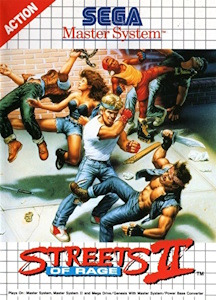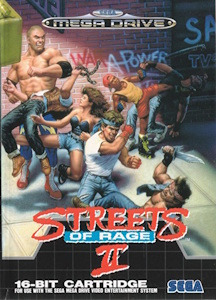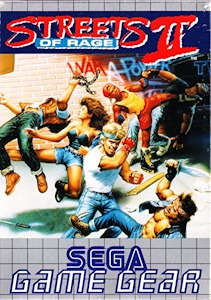Streets of Rage 2 (1992-)
Streets of Rage 2 was developed by Sega AM7 (also known as Ancient for parts of the soundtrack work) and released in 1992 for the Sega Mega Drive/Genesis. Published by Sega, it served as the direct sequel to the original Streets of Rage, which had established itself as a standout in the side-scrolling beat ’em up genre. While the Mega Drive version is the most recognised, the game was also ported to the Sega Master System and Game Gear, with scaled-down graphics and simplified gameplay, and later included in numerous Sega compilation releases across modern platforms.
The game follows returning heroes Axel Stone and Blaze Fielding, now joined by newcomer Max Thunder, a powerful wrestler, and Eddie “Skate” Hunter, the younger brother of Adam from the first game. Players battle through eight urban-themed stages, taking on waves of enemies and unique bosses to rescue Adam from the criminal mastermind Mr. X. Streets of Rage 2 expanded on its predecessor’s formula with larger sprites, smoother animations, and more varied movesets for each character, making combat more dynamic and strategic.
The soundtrack, composed primarily by Yuzo Koshiro and Motohiro Kawashima, is widely regarded as one of the greatest in video game history. Blending house, techno, and funk influences, it perfectly matched the gritty yet stylish tone of the game. Streets of Rage 2 built on the popularity of its predecessor, which had already gained a reputation for its music and co-op gameplay, and Sega promoted it through magazine previews, TV ads, and bundled deals with the Mega Drive in certain regions.
Reception was overwhelmingly positive, with critics praising its graphics, responsive controls, and groundbreaking soundtrack. It quickly became a flagship title for the Mega Drive, cited as one of the best beat ’em ups ever made and a key example of Sega’s early ’90s golden era. Streets of Rage 2 continues to be celebrated in retrospectives and fan communities, often considered the pinnacle of the series.
Key Features:
Four playable characters with distinct fighting styles
Two-player cooperative gameplay
Eight diverse urban stages with unique enemies and bosses
Expanded movesets including special attacks and throws
Iconic techno-inspired soundtrack by Yuzo Koshiro and Motohiro Kawashima
Crisp, colourful 16-bit graphics with smooth animation
Images from MobyGames
Buy Streets of Rage 2
Click one of the Ebay or Amazon buttons below to check the latest prices and purchase Streets of Rage 2 for that particular platform.



Related Searches
Streets of Rage 2 is available to purchase and download from a range of vendors. Always shop....
Streets of Rage 2 may be available to download as abandonware from one of the many sites that offer this...
There are various sites out there that can offer cheat codes for games. Search now to find all available...
There are many sites out there that have collated and documented historic reviews of this game. Search now...
We don't host or link to rom sites for this game. However, there are many sites out there that may be...
The initial release date for Streets of Rage 2 is stated as December 15th 1992. Other ports of the game may....
Streets of Rage 2 is available to purchase and download from the link(s) shown further up this....
There are multiple sites around the internet that offer visual guides to this game. Search now to find the....








